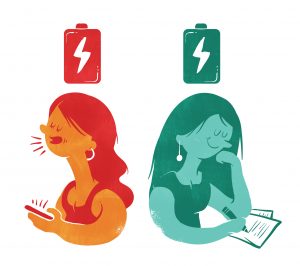Striking a balance between work, health, and happiness can be a difficult task. Advancing research makes it clear that supporting one’s mental and physical needs is essential to maximizing productivity. In his COMM292 Blog, Thao Atkinson writes about “karoshi”, a Japanese term meaning “death caused by over working”. Today, the workplace often provides counselling and mental health seminars that increase the perceived organizational support for employees. However, burnout still runs rampant in many organizations, where heavy stigma and fierce competition make it difficult to eliminate.
For many jobs, companies expect the displayed emotion of their employees to match with the values of the company and the impression they want to give to their consumers. For example, nurses need to constantly show sympathy and patience despite working long hours and doing emotionally taxing work. The discrepancy between displayed emotions and felt emotions can be draining on top of the emotional energy required to work, contributing to high levels of workplace related exhaustion.
Additionally, the competitive nature of many offices make it difficult to admit needing a break. When there are a limited amount of promotions available, employees do their best to make sure they stand out amongst their peers. While one could say that being self-aware enough to know where your limits lie, the heads of many companies interpret this as being incapable of handling pressure and not strong to do what others are not struggling to do. In fact, mental exhaustion can be the result of a number of factors not directly related to work. Unfortunately, this stigma can create even more emotional labour, which is often unseen and left untreated.
In an age where a work-life balance is of increasing value, it is essential for managers to adapt their systems to better suit the emotional needs of their employees. More focus must be placed on this underrated issue, which can drastically impact a company’s productivity and efficiency.

Word Count: 327
Image: source

